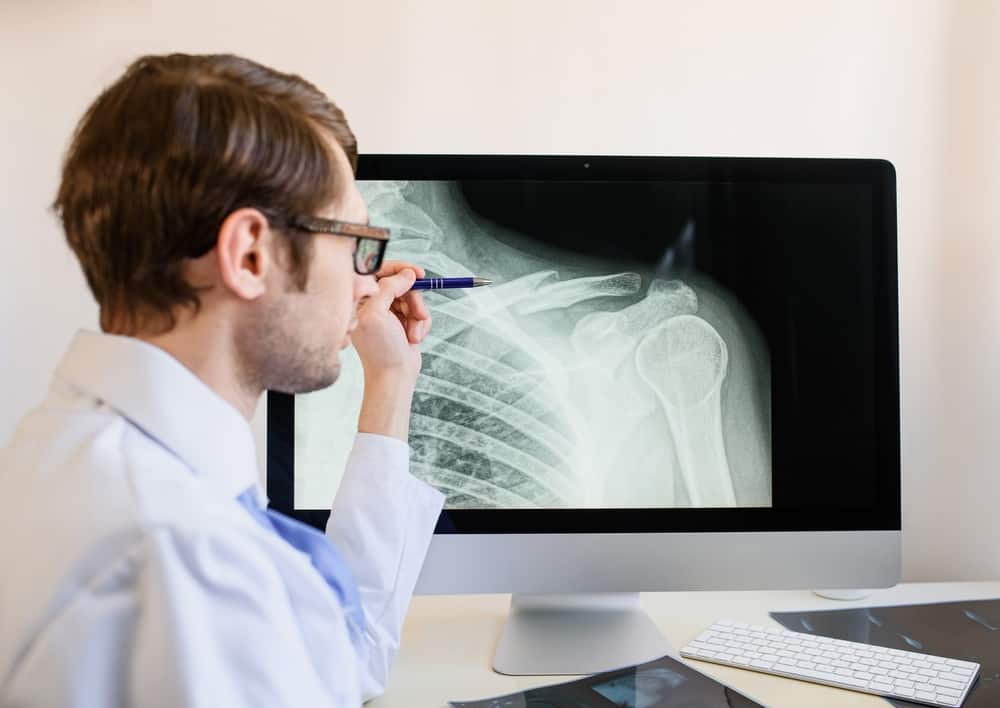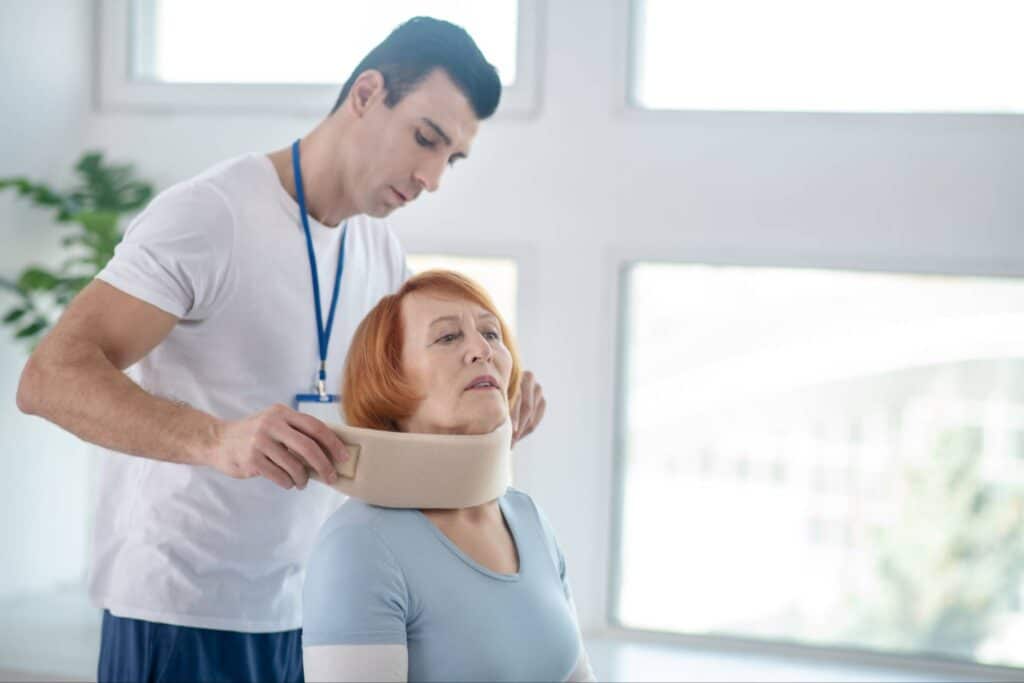The collarbone is also known as the clavicle. This bone goes across your chest and connects the breastbone to the shoulder blade. Unlike other bones in the body, the collarbone is more visible because it is located so close to the surface of the skin. This also makes it more susceptible to injury due to less soft tissue support. In some cases, a broken collarbone will heal with non-invasive procedures like a sling and physical therapy. However, a complicated break may require surgery to help realign the broken bone.
Visit orthopedic doctors in Atlanta near you as soon as possible if you suspect you have suffered a broken collarbone. Prompt medical attention can help support the healing process and reduce the risk of complications.
Anatomy of the Collarbone
The clavicle, or collarbone, is an S-shaped bone that connects the tops of your shoulders, known as the scapula, to the breastbone, also known as the sternum. The collarbone offers structural support for the chest and shoulders. Located above the first rib on either side of your chest, the collarbone sits perpendicular to the spine. Because the collarbone does not complete development until late adolescence, children and young adolescents are more susceptible to collarbone injuries. A broken bone or fracture is more common with the collarbone than other bones in the body because of its location and its frequent exposure to force.
Common Causes of a Broken Collarbone
From children to adults, here are four common causes of a broken collarbone.
Sudden Fall
A sudden fall can cause you to naturally outstretch your hands to catch yourself. When you fall on outstretched hands, the force of impact can jolt your arms and shoulders, which then puts an immense amount of pressure on your collarbone as you try to stabilize the upper body. A fall onto your side and shoulder can also lead to a broken collarbone.
Sports Injury
Those who play contact sports like football or hockey are at greater risk of sustaining a sports injury like a broken collarbone. A tackle to the upper body puts a lot of strain and force on the shoulders and chest. A direct blow to the shoulder or chest while playing a sport can also lead to clavicle fractures in sports.
Car Accident Injury
A car accident can also lead to a sudden injury like a broken collarbone. While wearing a seat belt to prevent a severe car accident injury, it can also lead to an injury when worn improperly or during a serious accident. The seat belt should be worn from shoulder to hip and helps prevent you from being ejected from the vehicle in the event of a crash. However, the force of impact can cause you to strain against the seat belt and put too much pressure on the collarbone. In an event of a car accident, you should not wait and wonder how soon should you see an orthopedic doctor. Go immediately to prevent a series of chronic conditions and potential impairments.
Birth Injury
Babies can also sustain a broken collarbone during the birth process. When moving through the birth canal during a difficult delivery, a clavicle fracture can occur. A broken collarbone is actually the most common injury that occurs in infants during birth.
Types of Collarbone Fractures
A collarbone can sustain a simple crack of the bone that may become badly displaced. Multiple breaks in the collarbone are known as segmental fractures. There are three main types of clavicle fractures that depend on where the injury occurs along the collarbone.
Mid-Shaft Clavicle Fracture
A mid-shaft clavicle is the most common type of broken collarbone and occurs in the thinnest part of the clavicle, known as the midshaft. This particular part of the collarbone lacks muscles and ligaments for support, which makes it more vulnerable to injury.
Distal Clavicle Fracture
A distal clavicle fracture occurs where the collarbone meets the shoulder blade. This area is known as the acromioclavicular joint, or AC joint. A direct blow to this area or a direct fall on the shoulder can cause a distal clavicle fracture.
Medial Clavicle Fracture
A medial clavicle fracture is the least common fracture and tends to occur alongside an injury to the sternoclavicular joint. This rare type of collarbone fracture affects the area of the collarbone closer to the sternum.
Broken Collarbone Symptoms
The most common symptoms of a broken collarbone include shoulder pain and difficulty moving your arm. Pain will typically occur in the shoulder and along the collarbone. Swelling and bruising may develop along the shoulder, across the chest, and near the armpit. The collarbone will typically be tender to the touch. A bump or deformity of the collarbone may be visible with a clavicle fracture. It may appear as though the shoulder is sagging forward or downward. This type of injury can make it difficult to raise your arm or move your shoulder. A grinding or crackling sound may also occur when you try to move your shoulder and arm. Other symptoms may include numbness and tingling that extend through the arm. Newborns with a broken collarbone will typically not move the affected shoulder or arm for a few days after the injury. Adults who experience any numbness or coldness in the arm or hand should seek medical attention as soon as possible.
Broken Collarbone Treatments
A doctor will typically diagnose a broken collarbone with a combination of a physical exam and diagnostic imaging like an X-ray or CT scan. Diagnostic imaging tools will help locate the precise location of the break and determine the severity of the injury. X-rays or CT scans of the shoulder and arm can also help rule out other injuries. Once your doctor determines the type and severity of the break, they will be able to determine the best course of treatment for you. The most common type of broken collarbone, midshaft clavicular fractures, typically respond well to non-invasive treatment options and allow the bone to heal naturally. Here are examples of treatment broken collarbone treatment options and when surgery may be recommended or required for a full recovery.
Immobilization
Immobilizing the area is key to recovering from any broken bone, especially the collarbone. An arm sling will help immobilize the area and keep you from moving around while the bone heals. A sling will also help keep your shoulder and arm in the proper position so that the injury can heal correctly. The length of time for immobilization will depend on the severity of your collarbone injury. For clavicle fractures in children, the collarbone typically heals in three to six weeks, while it can take six to 12 weeks for adults.
Home Remedies
Your doctor may recommend over-the-counter medications for pain relief and to help reduce inflammation. Depending on the type and severity of the break, your doctor may write a prescription medication to help manage the pain for the first few days after the injury. Applying ice to the area will provide a temporary numbing sensation and offer pain relief. Icing the area will also help control swelling and inflammation in the area.
Physical Therapy
A physical therapist can help you through the rehabilitation and recovery process after a broken collarbone injury. Physical therapy may begin within days of the initial treatment to reintroduce movement to the shoulder and arm gently and safely. At first, physical therapy will typically involve you still wearing your sling to help stabilize the area. Gentle stretches and exercises will help reduce stiffness and weakness from immobilization. As treatment progresses, you will be able to remove your sling and focus on improving strength, joint mobility, and flexibility. Physical therapy will help you regain your mobility and confidence to return to your regular routines and activities around 12 weeks after the initial injury. Age, fracture location, and any other injuries sustained at the time can impact the recovery time for a broken collarbone.
Surgery
A more serious broken collarbone injury may require surgery. In rare cases, the clavicle may break through the skin, known as a compound fracture. If the bone breaks in multiple pieces, it may also require surgery to reposition the bone for proper healing. Plates, rods, and screws are types of fixation devices that may be used to hold the collarbone in place properly. Children and young adults have a greater chance of avoiding surgery with a collarbone injury compared to adults. Physical therapy can also help with rehabilitation after surgery to help you regain strength and restore movement in your shoulder and arm.
It can take several months to fully heal from a broken collarbone, whether or not you require surgery. However, non-surgical options typically have fewer complications, and you may be able to safely resume activities within 3 months. Talk to your Atlanta orthopedic doctor about when you can start using your arm and shoulder again after a collarbone injury. At AICA Orthopedics, our team of orthopedic doctors in Atlanta will walk you through the benefits and risks of non-surgical treatment versus surgery so you can make the best decision for you and your health. Visit an AICA Orthopedics location near you to meet with our team of multi-specialty doctors, where you can meet with orthopedic doctors, surgeons, and physical therapists all in one convenient location.





